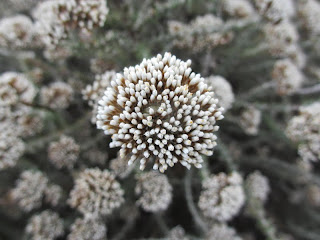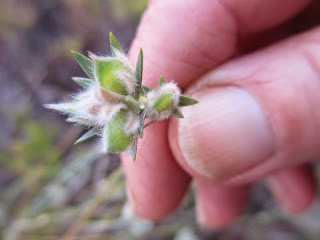There was less than one millimetre of rain forecast; most came this morning, but it left the day heavily overcast and gloomy!
During the week, Pippa found this Red Stinkhorn Clathrus archeri growing on the farm. It lives up to its name!
We didn't know what to expect today being dead-of-winter and overcast to boot, but as usual we weren't disappointed! This morning's rain can still be seen on this Prickly Pear, Opuntia flower:
We're so used to seeing the 'baubles' on the Brunias but it was a treat to see some of them in flower!
Raindrops on a Leucadendron:
A striking Metalasia:
Detail of a flower:
What might this be? We first thought it could be a Gnidia
Closer:
We don't think we've seen this before! Alison Steyn suggests it might be Amphithalea tomentosa. That belongs to the Fabaceae (pea) family and the flower did look pea-like!
A Teedia growing in a crack in the rockface:
We were checking up on 'our' plants in the area which has just been clear-felled. Here it looks a bit like the Somme on a bad day:
The view on the other side, of the Eikenhof Dam with cats' paws, was better. The Country Club is just showing on the near bank on the right:
We were pleased to uncover a Gnidia at the top which we thought had been smashed by the felling.
A splash of sunshine highlighted this Lobelia which we think might be L. pinifolia:
A Mimetes cucullatus which was luckily undamaged by the felling, is partly in flower. I'm not sure if there's more 'fluff' to come or if it's come and gone. It is now much more exposed than it was.
This late-flowering Liparia splendens or Mountain Dahlia is still completely covered in flowers, while others have long since finished.
One of the flowers up close, with raindrops:
Today I remembered to take a photo of the foliage of the daisy-type plant with the yellow flowers with three petals. There is a Dandelion look about the leaves! Any guesses?
A tallish pink Erica, leaves not in tufts, E. longifolia?
For a change, more than one flower was open on this Daisy. That caused me to go off the path for a picture, which deliberately shows detail of the leaves. Would they be described as 'fern-like'? If so, is it a Euryops?
Here's one of our 'normal' Lobelias, L. tomentosa, we think. It seems that the more difficult the circumstances they grow in, the better they flower! This is just one flower on a row of plants growing in the red pebbles which can be seen in the background, in the middle of the jeep track, making a strong blue stripe!
This looked like a Mom (behind) and Dad in front. Anina has kindly suggested that it looks like Hypodiscus argenteus:
Another interesting Restio. Anina's comment again: Not very clear, but looks like Hypodiscus aristatus male.
On the way into the farm we noticed a strange cloud over Hans se Kop, our rain predictor. It'll be clear for a while!
We weren't disappointed, despite the time of the year and the gloom!
:-) A
























So this week Andy really throws me, Clathrus archeri.indigenous to Australasia, introduced to most of the Northern Hemisphere, a white version grows on the sub continent but in my book no mention of Africa. He then shows an Opuntia, Indian Fig to me, like the Indian Bean, C. bignonioides, in one of my old local churchyards, not to do with India but named after the American Indians. Am I going on too much, one can never use too many words describing the magnificent plants, I could go on for ever, the Brunia and the Metalasia super, Liperias, Ericas, Lobelia and Euryops so colourful and all framed around those magnificent photos of the Eikenhof Dam and Hans se Kop. Truly wonderful.
ReplyDeleteThanks for your comments, Bernard! We are privileged to live here...
ReplyDelete